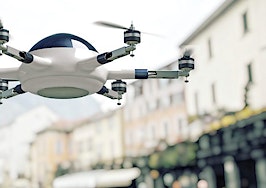- The National Association of Realtors will help develop a regulatory framework for the use of drones as part of a Federal Aviation Administration rulemaking committee.
- The goal is to gather recommendations and create separate regulation for small unmanned aircraft systems so they can be safely flown over people.
- In a statement on NAR’s participation on the FAA committee, current NAR President Tom Salomone reaffirmed the association’s consensus that drone technology "offers a tremendous opportunity for the business of real estate."
The National Association of Realtors (NAR) is among more than two dozen industry organizations invited to join a Federal Aviation Administration (FAA) committee that will help develop a regulatory framework for the use of drones.
Last year, the FAA proposed new regulations intended to govern “unmanned aircraft systems” (UAS), the official term for drone, including the creation of a “micro” classification for drones weighing 4.4 pounds or less. Following a public comment period, the FAA elected not to include that classification in the final rule, which will be released sometime later this year.
[Tweet “The FAA elected not to include the drone ‘micro’ classification in the final rule.”]
Instead, the agency will gather recommendations in creating a separate regulation for small UAS so they can be safely flown over people not directly involved in the operation of the aircraft without risk of hazard or injury.
“Based on the comments about a ‘micro’ classification submitted as part of the small UAS proposed rule, the FAA will pursue a flexible, performance-based regulatory framework that addresses potential hazards instead of a classification defined primarily by weight and speed,” said FAA Administrator Michael Huerta.
[Tweet “The committee will gather ideas to create a framework for the safe operation of small UAS.”]
The Aviation Rulemaking Committee (ARC), comprised of 26 different aviation stakeholders, will develop recommendations for the classification and operation of certain UAS, identify how UAS manufacturers can comply with the requirements and propose operational provisions based on the requirements.
The potential for aerial imagery in real esate
Anthony Foxx, secretary of the Department of Transportation, which oversees the FAA, pledged the department’s commitment to “be bullish on new technology.”
“We recognize the significant industry interest in expanding commercial access to the National Airspace System,” Foxx said.
NAR has been working with the FAA and other industry partners on integrating drones within the national airspace for commercial use since early 2014.
[Tweet “NAR has been working with the FAA on integrating drones for commercial use since 2014.”]
The association submitted comments to the agency during last year’s rulemaking, and last September, 2015 NAR President Chris Polychron testified on the commercial application and implications of UAS use before the House Judiciary Committee’s Subcommittee on Courts, Intellectual Property and the Internet.
Polychron emphasized the potential for aerial photography, videography and property inspection in the real estate industry.
In his testimony, Polychron noted that a Realtor from Arizona was one of the first people to successfully apply for and receive a Section 333 waiver, currently the only avenue available to fly a UAS for commercial purposes.
[Tweet “There’s great potential for aerial photos and property inspection in the real estate industry.”]
“Realtors are often early adopters of new technology,” Polychron testified. “Just as digital photography made it easier to create high-quality, affordable images, real estate practitioners look forward to using UAS technology to take their listings into the next level in technical creativity and quality.
“UAS technology can allow photographs to be taken from above a house to present a bird’s-eye view of the property, or from unique angles that are otherwise too difficult or expensive to access.
“The aerial imagery made possible through UAS technology will bring a new level of sophistication and accessibility to images and information, allowing the real estate professional to present a detailed portfolio to potential buyers, and thereby creating a more informed consumer before they even set foot on a property.”
Addressing safety and privacy concerns
Polychron also conveyed NAR’s concerns about the technology, which the association narrowed down to three primary focuses relating to the protection of citizen privacy and safety:
- Operations guidelines and accountability for operators
- Protecting the safety of bystanders during a UAS flight
- The FAA’s proposal to create a visual observer position to assist the operator during flights
“NAR understands the need for regulations that address privacy concerns,” Polychron testified. “The NAR Board of Directors adopted data security and privacy policy principles that guide association activity and member standards.
“Based on these principles, NAR has been active in both legislative and regulatory activities concerning data privacy and security. Real estate professionals understand, perhaps more than most, the importance to a homeowner of having privacy in his or her home and backyard, or to be able to guard against trespassers on private property.”
Rulemaking committee promises a quick turnaround
NAR has also developed a Field Guide to Drones and Real Estate.
In a statement on NAR’s participation on the FAA committee, current NAR President Tom Salomone reaffirmed the association’s consensus that drone technology “offers a tremendous opportunity for the business of real estate and the broader economy.”
[Tweet “The Aviation Rulemaking Committee will issue a final report to the FAA on April 1.”]
“NAR continues to support the integration of drones into the national airspace and a regulatory landscape that allows for the responsible commercial use of drones,” Salomone said. “Drones show real promise not only for photography, listing, and marketing purposes, but also for appraisals, inspections, maintenance and insurance, all of which can benefit real estate practitioners as well as consumers.”
The ARC will begin its work in March and issue a final report to the FAA on April 1.
“The short deadline reinforces our commitment to a flexible regulatory approach that can accommodate innovation while maintaining today’s high levels of safety,” Foxx said.





